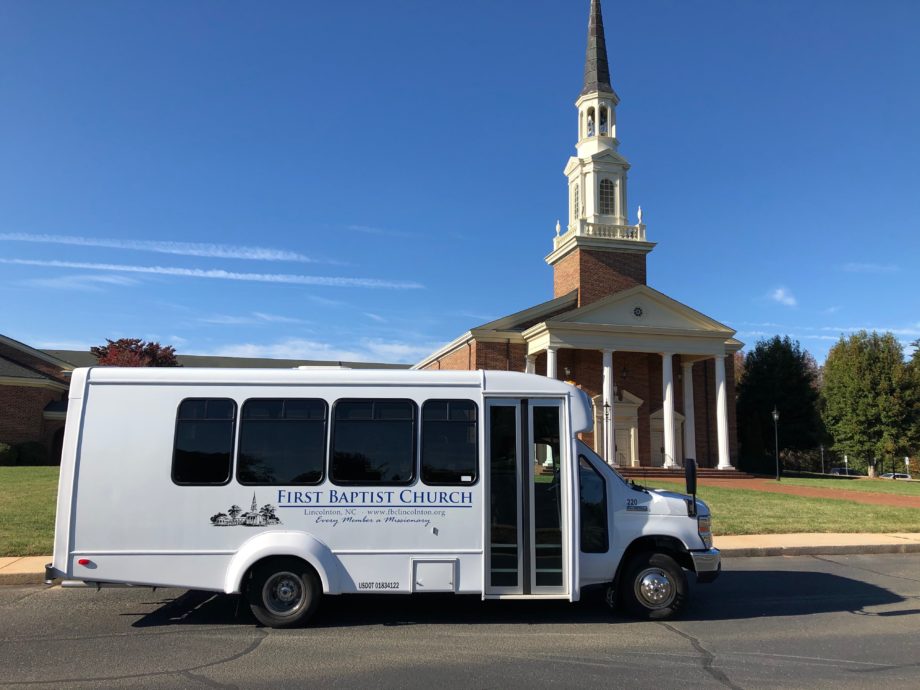Choosing the right vehicle for your church’s transportation needs can feel like a daunting task. Many decision-makers wind up in the classic church bus vs. a 15-passenger van dilemma. Carolina Thomas has been helping congregations navigate the long list of essential factors in this decision for many years.
When it comes to the costs, insurance, accessibility issues, safety features, and more, we are very familiar with the questions and concerns you might have. Let’s look at some of the primary reasons your church family would be better served with a bus than a 15-passenger van.

Insurance Costs and Prohibitions
After years of fatal accidents and federal reports warning drivers and organizations about the dangers of 15-passenger vans, many insurance companies have dramatically raised the cost of insuring these vehicles. Some providers completely refuse to insure them at all.
If your church is seriously considering purchasing or leasing a 15-passenger van for transportation, be diligent in your research about the cost of insurance. Many vans have a lower sticker price than buses, but that gap can quickly be closed or become more expensive in the long run with higher premiums.
Accessibility Concerns
If you have ever tried to climb into (or out of) the rear seats in a 15-passenger van, you understand why accessibility can be a primary concern for your church members.
- The shoulder seat belts on the end of the bench seat easily entangle passengers.
- The space riders must fit through to access the rear seats is narrow.
- It is easy to turn an ankle or suffer a knee/hip injury on the interior step of the van.
- Passengers may fall making the larger step down to the ground.
- Most 15-passenger vans have no lift and are not wheelchair accessible.
While some of these issues can be more easily navigated by the youth in your congregation, most passengers will have a difficult or impossible time maneuvering these limitations. The accessibility issues associated with vans is unsurprising since they were never designed to transport people in the first place.
By contrast, today’s buses are made with passenger accessibility and comfort as top priorities in the design and construction phases.
- Seatbelts are not obstructive and made exclusively for individual passenger seats.
- Center aisles provide easy and safe access for entering and exiting the vehicle.
- Full, wide steps provide adequate footing and eliminate large steps in and out of the bus.
- Lifts and access for persons in a wheelchair are commonly implemented customizations.
- Buses can be equipped with luggage storage compartments that keep the rear window clear of obstruction.
Safety Issues
The safety concerns for 15-passenger vans have been well-known and repeatedly documented for many years now. Churches continue to keep their old 15-passenger vans or decide to buy a new one for a variety of reasons. Finances are often a significant factor in this decision, and it can be tempting to choose a 15-passenger van because of the sticker price, in spite of the safety risks.
What are the primary safety concerns with 15-passenger vans?
Ejection: Nearly half of the fatalities in 15-passenger vans since 2007 were passengers who were thrown from the vehicle. Each passenger wearing a functional, properly-adjusted seatbelt is a critical factor in surviving a crash, and yet many passengers neglect to wear their seatbelt.
Tipping or Rolling Over: Even experienced drivers can easily lose control of a 15-passenger van in a single-vehicle accident. The design of these vehicles gives them a high center of gravity with a narrow wheelbase, which can be a recipe for danger with sudden course corrections or cornering too quickly.
Tire Failure: The National Highway Traffic Safety Administration (NHTSA) reports that 11% of fatal 15-passenger van accidents are due to some form of tire failure. Old tires, including previously unused spares that have deteriorated, can be a dangerous issue, as well as improperly inflated tires.
According to NHTSA, buses are the safest mode of land transportation on the planet. Superior visibility, accessible seat belts, dualrear-wheel designs, outward-opening doors, and many other safety features designed specifically for passengers make a bus a significantly safer option for your church transportation needs.
Our Recommendations Come From Hands-On Experience
Our team understands the difference between buses and vans so thoroughly because each member of our sales team used to work at a bus manufacturer. . We sell and service only buses, and we stand by every vehicle we sell with full warranties, bumper-to-bumper service and repair, customization, and parts . We can even offer finance and lease options designed to help you maximize your budget. We have many quality buses to fit a wide range of church needs and budgets. Browse our bus inventory online today.
 Skip to main content
Skip to main content